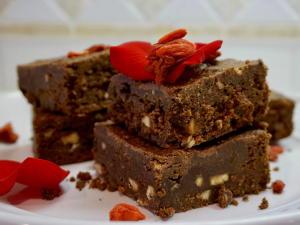However, they are often NOT aware of the impact that their diet has on their environmental reactions. If YOU are reacting to a tree or grass pollen, you are also likely reacting to specific foods as well. Additionally, if you are eating those foods at the same time you are suffering from hay fever, you can make your pollen-related allergies even worse.
Think about a bucket collecting water drops from a leak in the roof. Over time the bucket starts to fill until it eventually overflows. The overflow isn’t happening from a GUSH of water but from a slow drip. It’s similar here when we talk about the body’s histamine response.
When you eat foods that have a cross-reaction with specific environmental allergens, it is adding a drop to the bucket. Then the season changes and it creates the spillover effect and you experience symptoms like runny or stuffy nose, itchy throat, puffy eyes, fatigue, headache, hives, or sinus pressure.
About 60% of all food-related adult allergic reactions occur because of cross-reactions between food and pollen. Also, about 50-60% of people who are allergic to latex also have “latex-fruit syndrome” where they develop adverse reactions after consuming cross-reacting vegetables and fruits. Non-pollen-related cross-reactions like Candida’s association with yeast and gluten-containing foods cross-react with coffee, dairy, oats, and yeast.
The cross-reactivity between fruits, vegetables, and pollen that occurs in those who suffer from seasonal allergies is often called “oral allergy syndrome” because the symptoms occur in the mouth, lips, tongue, and throat. In other cases, the reaction to the offending food is more severe. Some people who have pollen-related food allergies also suffer from gastrointestinal symptoms. Whereas some people who consume cross-reacting food will go into anaphylactic shock.
So let’s dive into the typical environmental allergens or plants associated with seasonal allergies and the foods that have cross-reactions.
GRASSES
First, let’s address grasses. Those who suffer from a runny or stuffy nose, itchy throat, puffy eyes, fatigue, headache, hives, or sinus pressure due to exposure to grasses may experience a cross-reaction or “overload” while also consuming melons, oranges, watermelon, peaches, swiss chard, tomatoes, celery, white potatoes, rye, wheat, sunflower seeds, and canola, rapeseed or olive oil.
MUGWORT
Mugwort is a sage-colored plant that is commonly used for beer-making but is also thought to prevent or treat health conditions like anxiety, digestion problems, and irregular periods. However, many people consider Mugwort to be a common weed. This is because the plant spreads aggressively and can take over large parts of a garden. The plant is also related to ragweed and may cause allergies in people allergic to ragweed.
The foods that have cross-react with mugwort are melon, peach, watermelon, bell peppers, broccoli, cabbage, cauliflower, swiss chard, and onion; spices like anise, basil, caraway, dill, garlic, marjoram, mustard, paprika, black pepper, oregano, tarragon, and thyme; and nuts like almonds, hazelnuts, and walnuts.
RAGWEED
A ragweed plant only lives one season, but it packs a powerful punch. A single plant can produce up to 1 billion pollen grains. These grains are very lightweight and float easily through the air.
Fall allergy symptoms used to start in mid-August and run through September. However, in many parts of the country, these symptoms now begin in early August and extend through October. The cross-reactive foods include apple, banana, cantaloupe, honeydew melon, watermelon, celery, cucumber, white potato, zucchini, chamomile, honey, stevia, and sunflower seed.
TREE POLLEN
Another seasonal allergy complaint comes from exposure to tree pollen, in particular, Birch and Adler trees. The foods associated with a cross-reaction include apple, apricot, cherry, peach, nectarine, banana, fig, kiwi, lychee, pear, persimmon, plum, prune, orange, strawberry, carrot, celery, green pepper, parsnip, peas, spinach, tomato, white potato, almond, buckwheat, chestnut, hazelnut, honey, peanut, soybean, walnut, and wheat.
Herbs and spices that react with these trees are cilantro, coriander, parsley, anise, basil, caraway, chicory, cumin, curry powder, fennel, marjoram, oregano, paprika, pepper, tarragon, and thyme.
As you can see, there are a lot of cross-reactions associated with tree pollen!
LATEX
The last environmental allergen we must discuss is latex. Latex is made from the sap of rubber trees. It is very strong and stretchy. It is used in many common household items and toys like balloons, rubber bands, shoe soles, band-aids, gloves, condoms, paint, carpet backings, baby bottle nipples and pacifiers, clothing (like raincoats), handles on sports rackets and tools, diapers, buttons, and switches—to name a few!
The foods that cross-react with latex are avocado, banana, kiwi, mango, melon, papaya, tomato, apple, apricot, fig, orange, passion fruit, peach, pear, pineapple, strawberry, carrot, celery, white potato, buckwheat, peanut, soybean, and walnut.
The spices and herbs that cross-react with latex are dills, oregano, and sage.
To summarize, if you experience seasonal allergies, especially to any of the environmental allergens listed above, it can increase the likelihood of having certain food allergies and vice versa. Consuming the foods that fill the “bucket,” exacerbating an inflammatory reaction when paired with an allergen environmental exposure, can cause symptoms like itchy watery puffy eyes, stuffy nose, itchy throat, fatigue, headaches, hives, or sinus pressure.
Check out this related topic: “Seasonal Allergies and Histamine Intolerance with MOVE FULLY NOURISHED”
Your Online Dietitian Coach, Ashley Anderson MS, RDN, LDN, CPT, PN1

Your Online Dietitian Coach, Rachel Brown, RD, IBCLC, CDECS, MBA

***Click I’M READY to fill out our coaching application to schedule a complimentary discovery call TODAY! A healthier you is just a call away!***




